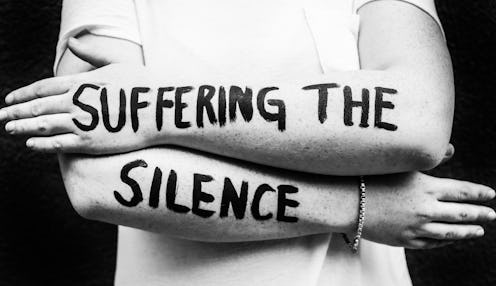
Most people think of illness as something you can see from the outside, but many ailments aren't visible to the naked eye. Allie Cashel, who is living with chronic Lyme disease, and Erica Lupinacci, who has Lupus, set out to make these conditions visible through their photography series Suffering the Silence: Portraits of Chronic Illness. The series draws attention to the illnesses and conditions we can't always see as casual observers, and reminds us that we can never make assumptions about anyone based solely on their outward appearance. Just because we can't see something doesn't mean it isn't there.
The photographs, taken by Amanda Crommett, depict people — including Cashel and Lupinacci themselves — with the names of their invisible illnesses written on their arms to reveal facets of their identities that aren't readily apparent. "We hope that the portraits will empower people across diagnoses to work together to break the stigma that currently surrounds chronic illness," Cashel tells Bustle via email. "And as more and more people speak up, I hope that this campaign can help to increase acceptance for some of the more controversial diseases so many of us are dealing with."
The Suffering the Silence website also calls for people with invisible illnesses to share their own photographs on social media. You can find these contributions at the Twitter handle @ststogether and the Instagram @sufferingthesilence and share your own by tagging these accounts.
Here are a few of the conditions featured in the series. You may know people who suffer from them without even realizing it, and the fact that they are invisible doesn't make them less difficult to deal with.
1. Lyme Disease
While Lyme disease is usually temporary, it becomes chronic for about 20 percent of the 300,000 Americans diagnosed each year. But because of the widespread belief that standard antibiotic therapy gets rid of the disease permanently, many chronic patients face dismissal from their friends, family, and even doctors, according to a description of Cashel's book Suffering the Silence: Chronic Lyme Disease in an Age of Denial , which comes out Sept. 8. The book, which details her own and others' experience living with chronic Lyme disease, is "an attempt to break the stigma and ignorance that currently surrounds chronic Lyme disease and other misunderstood chronic illnesses."
2. Lupus
The immune systems of those with Lupus, or Systemic Lupus Erythematosus, attack healthy tissue, leading to joint pain, swelling, and a slew of other possible symptoms. Cashel said that as she spoke with Lupinacci, she realized that the sigma faced by those with Lupus was similar to that of chromic Lyme disease patients. "Every day I’m trying to learn how to love a body I can’t control," Lupinacci writes on the collection's website. "The unpredictability can be the most painful aspect of this disease. I get scared that my body will keep me from living the life I envision but I’ve also decided I won’t let that fear hold me back."
3. HIV
When people find out you have HIV (Human Immunodeficiency Virus), which leaves the immune system vulnerable to infection, they "automatically disable you and don’t think that you can do anything else," writes Ty in the caption to his photo. Contrary to popular belief, he adds, the virus "doesn’t mean that I can’t date, that I can’t love, it doesn’t mean that I can’t do any of those things."
4. Scoliosis
Since her condition is not visible, writes Vivian, people don't always sympathize with the pain she experiences due to scoliosis, an abnormal curvature in the spine that affects three million Americans each year. "I think in their heads they think I’m lazy or making it up" rather than taking the condition seriously, she observes.
5. Endometriosis
Endometriosis is a little-known but often highly painful disorder in which the tissue lining the uterus grows in other nearby regions. Women complaining of this condition are often told they are just experiencing period cramps, explains Tatianna, but those with severe pain should seek help because there is likely more going on.
Head over to the Suffering the Silence website to learn about more conditions people suffer from silently and how we can break the stigma.
Images: courtesy of Amanda Crommett Photography